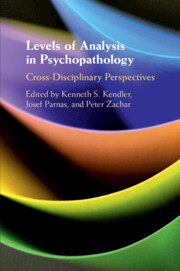Book contents
- Levels of Analysis in Psychopathology
- Advance Praise for Levels of Analysis in Psychopathology
- Levels of Analysis in Psychopathology
- Copyright page
- Contents
- Figures
- Tables
- Contributors
- Preface
- General Introduction
- Part I Neuroscience, Mechanisms, and RDoC
- Part II Phenomenology, Biological Psychology, and the Mind–Body Problem
- Part III Taxonomy, Integration, and Multiple Levels of Explanation
- Section 8
- Section 9
- Section 10
- Section 11
- Section 12
- Section 13
- Section 14
- Section 15
- 43 Introduction
- 44 Entity Focus: Applied Genetic Science at Different Levels
- 45 Commentary on “Entity Focus: Applied Genetic Science at Different Levels” by Eric Turkheimer
- Index
- References
43 - Introduction
from Section 15
Published online by Cambridge University Press: 02 April 2020
- Levels of Analysis in Psychopathology
- Advance Praise for Levels of Analysis in Psychopathology
- Levels of Analysis in Psychopathology
- Copyright page
- Contents
- Figures
- Tables
- Contributors
- Preface
- General Introduction
- Part I Neuroscience, Mechanisms, and RDoC
- Part II Phenomenology, Biological Psychology, and the Mind–Body Problem
- Part III Taxonomy, Integration, and Multiple Levels of Explanation
- Section 8
- Section 9
- Section 10
- Section 11
- Section 12
- Section 13
- Section 14
- Section 15
- 43 Introduction
- 44 Entity Focus: Applied Genetic Science at Different Levels
- 45 Commentary on “Entity Focus: Applied Genetic Science at Different Levels” by Eric Turkheimer
- Index
- References
Summary
Imagine a society, which strongly disapproves of divorce. It is not illegal, but it is considered as a very bad, transgressive and immoral thing. Due to the activist pressure from certain well-organized groups, a National Psychiatric Association introduces to its diagnostic manual of mental disorders a new category Divorce Tendency Disorder (DTD). You suffer from the DTD if you have divorced more than once. DTD is further divided into subtypes: (1) divorce on your own initiative, (2) divorce on your spouse’s initiative, (3) mixed type and (4) not otherwise specified. The creation of this diagnostic category stimulates a lot of scientific research. National Institute of Health and Prevention invests large sums of money into epidemiological and biological research. It turns out that DTD may be comorbid with a Personality Disorder, a Suicidal Behavior Disorder or Drug and Alcohol Dependence. Genetic-epidemiological studies show that DTD runs in families and twin data indicate genetic and earlyenvironmental effect. A genetic consortium using large sample studies shows that DTD is massively polygenic.
- Type
- Chapter
- Information
- Levels of Analysis in PsychopathologyCross-Disciplinary Perspectives, pp. 519 - 520Publisher: Cambridge University PressPrint publication year: 2020



